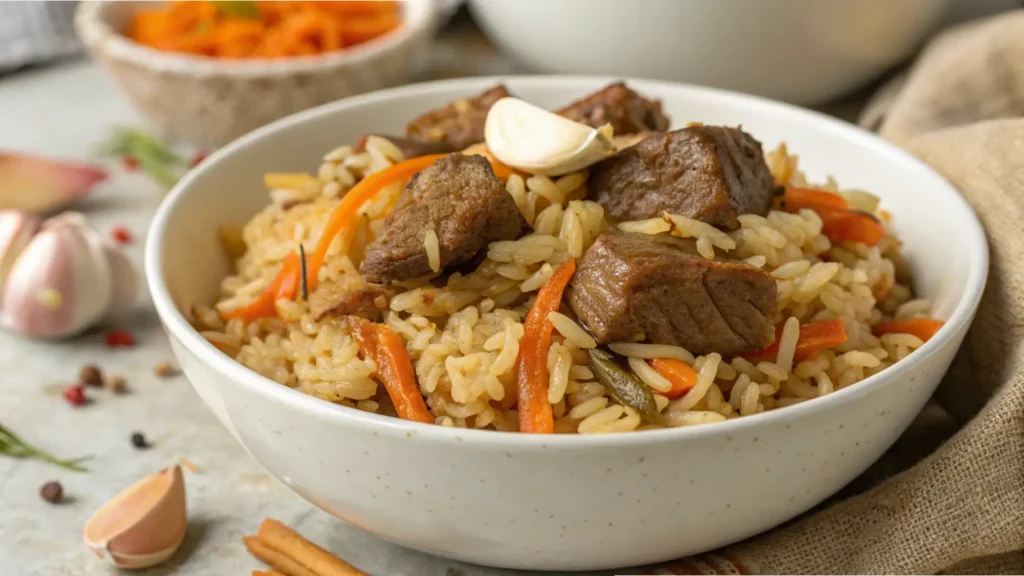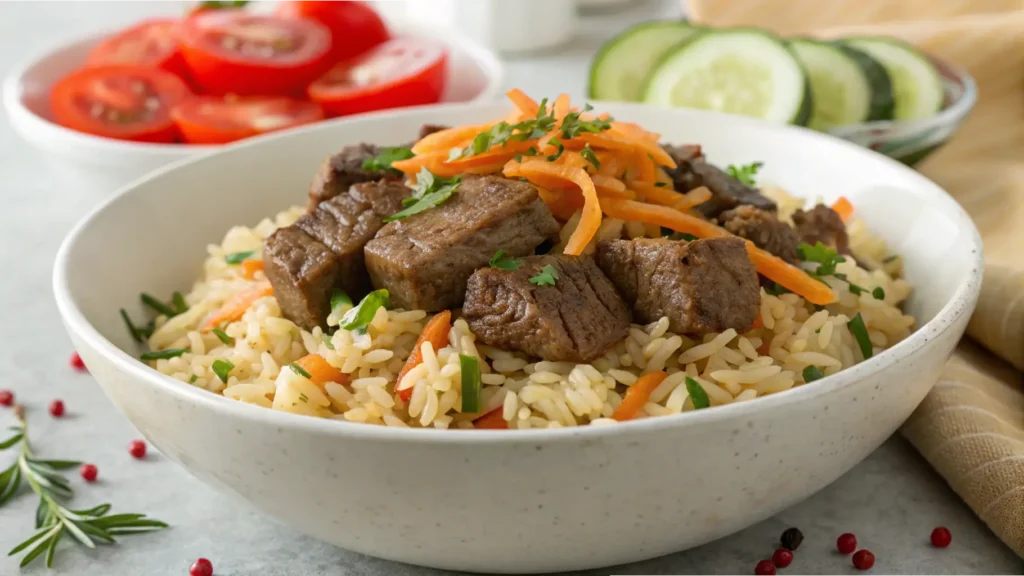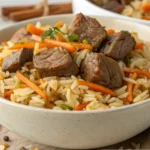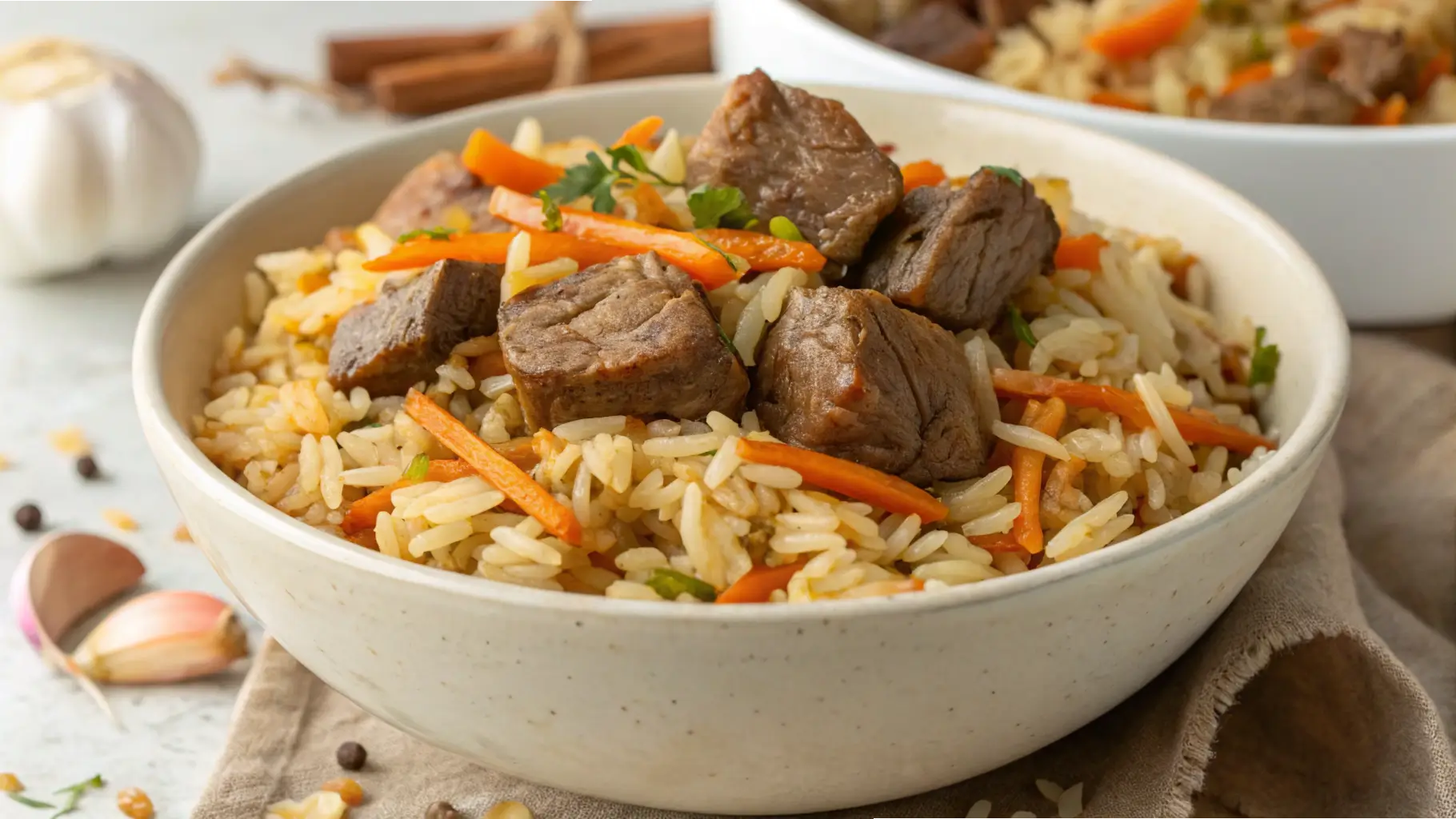Looking for a heartwarming, one-pot dish that’s bursting with flavor and steeped in centuries of tradition? You’re in the right place. In this article, we’ll take a flavorful journey through one of Central Asia’s most beloved comfort foods—Plov. Often known as Uzbek rice pilaf, this dish blends tender meat, fragrant rice, and a rich spice mix to create something truly unforgettable.
Whether you’re new to the world of Plov recipes or looking to fine-tune your cooking skills, we’ve got you covered. From its colorful history and essential ingredients to step-by-step cooking instructions, this guide delivers everything you need to master the authentic plov recipe. We’ll also explore regional variations, serving tips, and even answer the most frequently asked questions, all while keeping things simple and practical for home cooks.
Let’s kick off with a look into what makes Plov such a legendary dish.
Table of contents
What is Plov? A Cultural and Culinary Icon

Plov isn’t just a dish—it’s a culinary tradition. Found across Uzbekistan, Tajikistan, and other parts of Central Asia, Plov (sometimes spelled “palov” or “pilaf”) is the kind of meal that brings people together. At weddings, family gatherings, or casual Friday nights, there’s always room for a pot of this soul-satisfying dish.
At its core, a traditional Plov recipe combines long-grain rice, tender chunks of lamb or beef, onions, carrots, garlic, and a rich blend of spices. What sets it apart from other rice dishes is the layered cooking technique, which infuses the grains with savory goodness from top to bottom.
Why Plov is Beloved in Central Asian Cuisine
In many ways, Plov is a symbol of hospitality and celebration. Across Uzbekistan, it’s even considered a national dish. But don’t let the simplicity fool you—cooking the perfect Plov takes patience, care, and a bit of local know-how.
Its allure lies in how it balances flavors and textures—soft rice, juicy meat, and the slight caramelization of onions and carrots. When made right, each bite is a mini explosion of flavor.
Stick with us, and by the end of this guide, you’ll have an Uzbek Plov recipe that’s sure to impress—even if it’s your very first try!
Origins and History of Plov
Historical Roots: From Persia to Uzbekistan
To truly appreciate any Plov recipe, it’s worth taking a step back in time. Believe it or not, Plov isn’t just a modern kitchen favorite—it’s a dish with roots that stretch back over a thousand years. Originally, it’s believed to have come from ancient Persia, where rice pilafs were first cooked with meats, dried fruits, and spices. From there, the recipe traveled along the Silk Road, soaking up regional flavors along the way.
As the dish made its way east, it was adopted—and perfected—by Central Asian cultures. In Uzbekistan, Plov became more than just food; it became tradition. It’s no exaggeration to say that every family has its own spin on the Plov recipe, passed down through generations.
Plov Variations Across Regions
Though Uzbekistan proudly calls it their national dish, Plov isn’t exclusive to one country. Across Central Asia, variations of Plov recipes appear on tables from Kazakhstan to Tajikistan to Azerbaijan. In Tajik cuisine, it’s often called osh, and it may be spiced differently or include dried apricots. Meanwhile, Afghan versions might feature raisins and nuts.
The beauty of Plov lies in its adaptability. Wherever it’s made, it remains a symbol of generosity and home-cooked love. So, whether you’re learning the traditional Uzbek way or putting your own twist on it, you’re still part of a centuries-old story.
Ingredients for Authentic Uzbek Plov
Essential Ingredients You’ll Need
You can’t whip up a solid Plov recipe without the right ingredients—and quality really matters here. The dish may seem simple, but each component brings depth and texture to the final result.
At the heart of every Uzbek Plov are a few key players: long-grain rice (preferably basmati or devzira), chunks of lamb or beef, yellow or white onions, and bright orange carrots. Don’t forget the whole garlic bulb—yes, the whole thing—tucked into the pot near the end for a sweet, mellow punch.
You’ll also need vegetable oil or animal fat (like lamb tail fat for a truly traditional touch), salt, cumin seeds, and black pepper. Some regions toss in barberries or chickpeas, too. And of course, water—though it’s not fancy, it’s critical for cooking the rice just right.
Choosing the Right Meat and Rice
When it comes to choosing meat, lamb is the go-to in most authentic Plov recipes. It adds rich flavor and tender texture, especially if you include some fatty cuts. However, beef works wonderfully too, especially if it’s marbled.
Rice is where things can make or break your dish. Traditional Uzbek cooks often use devzira, a reddish, unpolished rice that’s ideal for soaking up flavor without going mushy. But don’t stress—basmati makes a fine substitute. Just rinse it well before using to avoid clumping.
Get your ingredients right, and you’re halfway to Plov perfection.
Cooking Equipment and Techniques
Using a Kazan: The Traditional Plov Pot
If you want to go all-in on authenticity, you’ll want a kazan. This heavy, cauldron-like pot is the soul of many Central Asian dishes, especially a proper Plov recipe. It’s round, deep, and made to handle open-fire cooking—perfect for evenly distributing heat and getting that slightly crispy rice layer at the bottom known as qazmaq.
But don’t worry if you don’t have a kazan lying around. A cast iron Dutch oven or heavy-bottomed pot works just fine. What matters most is that your pot retains heat and allows the ingredients to layer and steam properly.
Alternatives for Home Cooks Without a Kazan
No kazan? No problem. You can totally use a deep nonstick pot or even a wide sauté pan with a lid. The trick is controlling the heat—start high for searing the meat, then reduce it when it’s time to steam the rice.
Also, don’t skip the steam stage! Covering your pot tightly (a layer of foil under the lid helps) is what locks in moisture and flavor. This part is key to nailing the texture of your Plov.
Craving more rice-based comfort meals? Check out our Anjappar Style Egg Fried Rice Recipe, or dive into Southern vibes with this Smothered Chicken and Rice Recipe.
Step-by-Step Plov Recipe
Preparing the Ingredients
Before anything hits the pot, gather and prep your ingredients. This step saves time and ensures everything cooks smoothly. You’ll need:
- 2 cups long-grain rice (basmati or devzira)
- 1 lb lamb or beef (cut into cubes)
- 2 large carrots (cut into matchsticks)
- 1 large onion (sliced thin)
- 1 head of garlic (whole, unpeeled)
- ½ cup vegetable oil or lamb fat
- Salt, pepper, cumin, optional barberries or chickpeas
Rinse the rice well until the water runs clear—this helps it stay fluffy and not sticky. Also, soak it in warm water while you start cooking the meat.
Cooking the Meat and Vegetables (Zirvak Stage)
Heat your oil in a heavy pot. Once hot, brown the meat until it gets a nice crust. Toss in the onions and stir until they’re golden and sweet-smelling. Then add the carrots and cook until softened.
At this point, add your spices—salt, black pepper, and cumin go a long way. Pour in about a cup of water and simmer for 10–15 minutes. You’ve just made zirvak—the flavorful base of your Plov recipe.
Looking for more bold, flavorful meals? Try this Street Corn Chicken Rice Bowl or explore the spices in Birria Tacos.
Adding the Rice and Final Steaming
Drain the soaked rice and layer it on top of the meat and veggies. Don’t stir. Gently add water until it covers the rice by about half an inch. Nestle the whole garlic head right in the middle.
Let it boil uncovered until the water mostly evaporates—about 10 minutes. Then reduce the heat, cover tightly, and let it steam for 20 minutes. Avoid lifting the lid!
Once done, fluff the rice gently with a wooden spoon. Your Plov should be soft, rich, and aromatic.
Tips for Getting the Crust (Qazmaq/Tahdig)
Want that crispy bottom layer? Once the rice is steamed, crank the heat back up for 2–3 minutes. Listen for the sizzle—then turn off the heat and let it sit for 10 minutes. That’s how you get that dreamy golden crust without burning it.
For another hearty rice-and-meat combo, don’t miss our Italian Sausage and Tortellini Guide—it’s pure comfort in a bowl.
Serving and Presentation

How Plov is Traditionally Served
Once your Plov is ready, it’s time for the best part—serving it! Traditionally, Plov is brought to the table in one big, beautiful heap on a large platter. The goal is to show off the rich golden rice, tender meat, and that irresistible pop of orange from the carrots.
Often, the whole garlic bulb is placed right in the center as a kind of rustic garnish. Guests dig in family-style, which adds to the sense of community and celebration. In Uzbek culture, Plov is more than a meal—it’s a centerpiece.
If you’re serving this Plov recipe at home, you can keep things casual or dress it up for a special occasion. Either way, it’s sure to wow your guests.
Garnishes and Side Dishes to Accompany Plov
While Plov is a complete meal on its own, adding sides can enhance the experience. A fresh tomato and cucumber salad, lightly dressed with vinegar and herbs, makes a crisp, cool contrast to the warm rice dish.
You can also serve it with pickled vegetables, flatbread, or a side of plain yogurt for a creamy touch. A sprinkle of chopped parsley or dill on top adds both flavor and color. Presentation counts—and with Plov, it’s easy to make it shine.
Common Mistakes and How to Avoid Them
Overcooking or Undercooking the Rice
Cooking rice sounds simple, right? But with Plov, it’s where most folks slip up. If you don’t rinse the rice thoroughly, it can turn sticky and clump together. On the flip side, using too little water—or not letting it steam long enough—can leave it dry and underdone.
To nail this Plov recipe, always rinse and soak your rice before cooking. Keep an eye on the water level as it boils. Once it’s nearly gone, cover the pot tightly and let it steam undisturbed.
Incorrect Meat-Rice Ratios and Not Layering Properly
Another common pitfall? Skimping on the meat or overloading with rice. Plov is all about balance. Too much rice can leave the dish bland, while too little makes it overly greasy. Aim for a 1:2 meat-to-rice ratio as a good rule of thumb.
Also, remember to layer—don’t stir once the rice is added! This helps the flavors settle naturally, giving your Plov recipe that distinct, rich taste. Stirring too soon can lead to uneven cooking and mushy texture.
By avoiding these simple missteps, you’ll set yourself up for Plov perfection. Practice makes perfect, and each pot teaches you something new!
Plov Variations Around the World
Pilaf vs. Plov: Are They the Same?
You might’ve heard the term pilaf used in recipes from other cultures—and you’re not wrong to wonder if it’s the same as plov. While the two dishes are definitely cousins, they’re not identical. Pilaf is a broader term used in Middle Eastern, Indian, and Mediterranean cuisines. It usually involves rice cooked with broth, spices, and sometimes nuts or dried fruits.
Plov, on the other hand, has a more defined identity, especially in Uzbek and Central Asian cooking. The key difference lies in how the ingredients are layered and steamed. A traditional Plov recipe builds deep flavor by first cooking meat and vegetables separately before adding rice—then sealing it all together for that slow steam.
So yes, they’re related—but plov brings a bolder, more rustic vibe to the table.
Vegetarian/Vegan and Fusion Plov Options
What if you’re not into meat? No worries—Plov is incredibly flexible. Many home cooks create vegetarian or even vegan versions of the classic Plov recipe. You can swap the lamb or beef with mushrooms, chickpeas, or tofu for a protein boost.
Fusion takes are also on the rise. Some folks add saffron, turmeric, raisins, or even cashews to give their Plov a modern twist. While purists may stick to tradition, there’s no harm in exploring your own flavor path. After all, great food is all about making it your own.
Storage, Reheating, and Meal Prep
Best Ways to Store Leftover Plov
Got leftovers? Lucky you—Plov tastes even better the next day. Once it’s cooled, transfer it into an airtight container and pop it in the fridge. It’ll keep for about 3 to 4 days without losing its flavor.
If you made a big batch of your favorite Plov recipe, you can also freeze it. Just portion it out, seal it tightly, and store it in the freezer for up to a month. Be sure to label the containers for easy grab-and-go meals later.
Freezing and Reheating Tips
To reheat Plov, add a splash of water or broth to keep the rice moist. Then warm it in a covered skillet over medium heat or microwave it in a bowl with a lid. Stir halfway to ensure even heating.
This makes Plov a perfect meal-prep option. It holds up beautifully, and every bite still bursts with the bold, rich taste you love from the original Plov recipe.
FAQs
What is the best cut of meat for Plov?
For the most flavorful Plov recipe, lamb shoulder is the top choice. It has the perfect balance of fat and tenderness, which keeps the dish juicy and rich. If lamb isn’t your thing, beef chuck or brisket works well too. The key is using a cut that becomes tender with slow cooking, without drying out.
Is Plov Russian or Uzbek?
While many people associate Plov with Russia, it actually has deep roots in Uzbek cuisine. It’s the national dish of Uzbekistan and plays a big role in celebrations and family gatherings. That said, it’s also enjoyed across Central Asia and former Soviet countries—including Russia—each with their own twist on the Plov recipe.
What is the difference between Plov and Pilaf?
Both dishes share a foundation of rice cooked with broth, spices, and add-ins like meat or veggies. However, Plov is more specific in its method. A traditional Plov recipe involves layering ingredients and cooking them in stages—first browning the meat and vegetables, then steaming the rice on top. Pilaf is a broader term that varies more in technique depending on the region.
How healthy is Plov?
That depends! Traditional Plov can be heavy due to the oil and fatty meats. But it’s easy to lighten it up—use lean beef or chicken, go easy on the oil, and add more vegetables. When made mindfully, a Plov recipe can be both hearty and wholesome.
What is the difference between osso bucco and gravy beef?
Both are flavorful cuts used in slow-cooked dishes. Osso bucco is cross-cut veal or beef shank with a bone in the center, ideal for braising. Gravy beef, often from the shoulder or shin, is boneless and great for stews. While tasty, neither is traditional in a Plov recipe.
Why is Plov yellow?
Great question! The golden hue in Plov often comes from carrots and sometimes turmeric or saffron, depending on the region. When cooked down with the oil and meat, carrots release natural color that tints the rice, giving it that beautiful, warm glow.
Conclusion
Mastering a traditional Plov recipe might seem intimidating at first, but once you try it, you’ll see how rewarding it is. From its rich cultural roots to the satisfying depth of flavor in every bite, Plov truly is comfort food at its best.
Remember to focus on quality ingredients, proper layering, and a bit of patience. Whether you follow the classic method or add your own spin, you’ll create something memorable.
So, don’t wait—grab that pot and get cooking. Once you taste homemade Plov, you’ll wonder how you ever lived without it.
Print
Authentic Uzbek Plov
- Total Time: 70 minutes
- Yield: 1 large pot of Plov 1x
Description
Dive into the heart of Central Asia with this rich, one-pot Uzbek Plov recipe. A cultural icon and comfort food staple, Plov blends tender lamb or beef, fragrant long-grain rice, sweet carrots, and aromatic spices into a soul-warming dish. Perfect for family dinners or festive gatherings, this layered rice pilaf captures centuries of tradition and flavor in every bite.
Ingredients
-
2 cups long-grain rice (basmati or devzira)
-
1 lb lamb shoulder or beef chuck, cut into 1-inch cubes
-
2 large carrots, cut into matchsticks
-
1 large yellow or white onion, thinly sliced
-
1 head of garlic (whole, unpeeled)
-
½ cup vegetable oil or rendered lamb fat
-
1 tbsp kosher salt (adjust to taste)
-
1 tsp ground black pepper
-
1 tsp whole cumin seeds
-
2 tbsp barberries or cooked chickpeas (optional)
-
4 cups water (for cooking)
-
Fresh herbs for garnish (optional)
Instructions
-
Prepare the rice: Rinse the rice under cold water until it runs clear. Soak in warm water for 20–30 minutes while you start cooking.
-
Brown the meat: Heat oil in a heavy-bottomed pot or Dutch oven over medium-high heat. Add the meat and sear until browned on all sides.
-
Cook the vegetables: Add sliced onions to the pot and cook until golden. Stir in the carrots and cook for 5–7 minutes until softened.
-
Build the zirvak: Season with salt, pepper, and cumin seeds. Add barberries or chickpeas if using. Pour in 1 cup of water and simmer uncovered for 10–15 minutes to form a flavorful base (zirvak).
-
Layer the rice: Drain the soaked rice and gently layer it over the meat and vegetables—do not stir. Flatten with the back of a spoon.
-
Add garlic and cook rice: Press the whole garlic head into the center. Carefully pour in enough water to cover the rice by about ½ inch. Bring to a boil and cook uncovered until the water mostly evaporates (about 10 minutes).
-
Steam: Reduce heat to low. Cover tightly with a lid (use foil for extra seal if needed) and steam for 20 minutes without lifting the lid.
-
Rest and fluff: Remove from heat and let the plov sit, covered, for 10 minutes. Then gently fluff the rice and mix layers before serving.
-
Serve: Plate on a large dish, placing the garlic bulb in the center. Garnish with fresh herbs if desired.
Notes
- For best results, use a kazan or Dutch oven for even heat distribution.
- Devzira rice is traditional, but basmati works well as a substitute.
- To achieve a crispy bottom (qazmaq), increase heat for 2–3 minutes after steaming, then let it rest before serving.
- Great for meal prep—Plov tastes even better the next day!
- Prep Time: 20 minutes
- Cook Time: 50 minutes
- Category: Dinner
- Cuisine: Central Asian
Nutrition
- Calories: 620 kcal
- Fat: 24g
- Carbohydrates: 70g
- Protein: 30g

